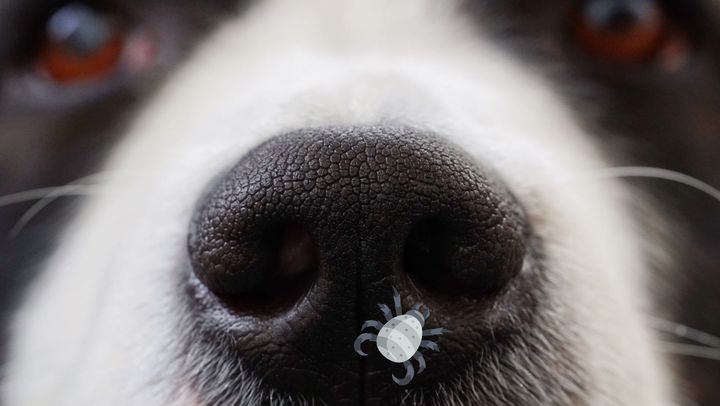Do Dogs Have Fall Allergies? What are Dogs Allergic to?

As humans do, dogs frequently experience fall allergies, which can result in a range of symptoms from teary eyes to skin issues.
While both spring and summer are frequently to blame for seasonal allergies, other allergens can also be found during the colder months of the calendar year, namely September, October, and November.
What can dogs be allergic to in the fall?

Fall allergies are pretty common in dogs of all sizes and breeds. Dog allergies to the fall season are typically brought on by seasonal plants that release pollen into the atmosphere.
Therefore, dogs react to particular allergens, generally environmental:
🍁 Ragweed and Pollen
When the weather starts to cool off during this season, various plants, most notably ragweed, discharge pollen. The pollen can also travel great distances during the fall winds.
🍁 Mold
In the fall, both indoor and outdoor mold growth is typical. Mold can thrive in wet environments with a lot of fall leaves.
🍁 Dust & Dust Mites
Additionally, common triggers of allergies are dust mites. When the heating system is turned on for the first time in the fall season, both people and dogs may be exposed to more dust including dust mites.
🍁 Fleas
In more temperate regions, even fleas can thrive in the fall when the temperature is still pleasant and their environment is moister.
Allergic reactions in dogs during the fall

Common fall season allergy symptoms in dogs, also known as atopy are:
- Itchy skin or ears, especially on the eyes, paws, belly, or inner thighs
- Watery or/and red eyes
- Skin infections, rashes, scabs, or red skin
- Sneezing or/and coughing
- Stomach discomfort might be present (rarely)
- Ear odor or ongoing ear infections
- Hair loss
- Diarrhea
Depending on what a dog is allergic to and how serious their symptoms are, these signs may only be seen during a certain season (fall, in this case) or they may become year-round.
👉 When your dog exhibits one or more of these allergy symptoms, you should visit the vet right away for an evaluation and for an appropriate treatment plan.
How long do fall allergies last in dogs?
If you're wondering how long it takes for a dog to recover from an allergic reaction, the organism of your dog will determine the answer. Usually, when an allergen is eliminated, symptoms typically subside within a few hours but can continue for two to three days.
Causes of Fall Season Allergies in Dogs
As mentioned above, dog allergies to the fall season are typically brought on by seasonal plants that release pollen into the atmosphere. But what about the causes?
The causes of these fall allergies are related to the immune system:
- An immune system that is overly sensitive to a specific substance
- An allergic reaction brought on by an overactive immune system, such as atopic dermatitis
- The immune system that fights a normally innocuous agent
The best and most successful course of action is to schedule an appointment with a veterinarian because every dog is unique and responds to autumn allergies differently.
Take your dog to the vet for diagnosis ✅
Make a visit to your vet if you notice any new or strange symptoms in your dog during the fall season. Your vet will examine your dog's clinical indicators, and will most likely start with a thorough physical examination.
To make your vet's work easier, try to remember and tell him everything he/she asks you about your dog's symptoms:
- how intense its symptoms are
- when they first appeared
- how long they lasted
- where do they seem to get worse: indoor or outdoor?
The vet might determine that your dog has seasonal allergies after checking his skin and other symptoms and after hearing your answers. There are various medical options that can help your dog feel better again if it has seasonal allergies, which are not uncommon in dogs.
What helps dogs with fall allergies?
The treatments of fall season allergies in dogs are multiple, but your med will give you the best after the examination.
He/she might want to begin gradually to evaluate what works for your mate before introducing further medicine if necessary. Options for treatment include:
💊 Medications
🧴 Shampoo
🐶 Desensitization Therapy
🍂 Summing up
It could be tough at first to figure out what works to make your dog feel better if they have fall allergies.
You will discover the remedy that is most effective for your dog once you are more aware of the precise allergens to which he is allergic.
Additionally, as you become more familiar with the symptoms of allergies, you will know when to contact your veterinarian for support or a prescription change when any new symptoms appear.
Any other steps you can take to ensure your dog's well-being throughout the fall will be recommended by your veterinarian. It's crucial to keep an eye out for any additional symptoms that could indicate the presence of different allergens, such as potential seasonal allergies.
Sources:
- Santoro D, Marsella R. Animal Models of Allergic Diseases. Veterinary Sciences. 2014; 1(3):192-212. https://doi.org/10.3390/vetsci1030192
Related Posts:




Comments ()